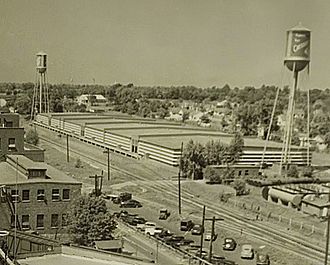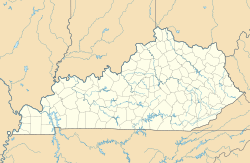Liggett and Myers Harpring Tobacco Storage Warehouse facts for kids
The Liggett and Myers Harpring Tobacco Storage Warehouse is a large building in Lexington, Kentucky. It was built in 1930. This warehouse is very important because it shows how big the burley tobacco industry was in Lexington between 1930 and 1980. Today, it is listed on the National Register of Historic Places listings in Fayette County, Kentucky. This means it is a special historical building.
Contents
History of the Tobacco Warehouse
After World War I, Lexington became the biggest market for burley tobacco in Kentucky. More tobacco warehouses were built across the city. This huge demand for burley tobacco led a company called Liggett and Myers to build a new tobacco facility in Lexington in 1930.
Building the Harpring Warehouse
A newspaper article from 1930 announced the construction of this new warehouse. It cost $100,000 to build. Liggett and Myers planned to use it for storing tobacco. The tobacco would wait there before being shipped to their factories. The new warehouse was ready for the tobacco season that winter.
The warehouse is located on Manchester Street, near the L&N Railroad. It was named after F. G. Harpring of Louisville. He was Liggett and Myers' main tobacco buyer in Kentucky. This new warehouse joined many other tobacco buildings in Lexington's northwest tobacco area.
A Big and Important Building
In November 1930, the Lexington Leader newspaper praised the Harpring Storage Warehouse. It called it "one of the largest and finest roofing and sheet metal jobs." The James D. Harper firm built it. The article described how much metal was used. This showed how big the warehouse was. It was a major investment for Liggett and Myers.
Between 1930 and World War II, Lexington's tobacco industry grew a lot. The city became a major hub for tobacco. Many new warehouses were built. These were often made of metal and steel. The Harpring Warehouse started storing tobacco in 1930. Its design was so good that other companies quickly copied it. In 1931, other national tobacco companies built similar storage warehouses.
Tobacco's Impact on Lexington
The Harpring Storage Warehouse was built at a key time for Liggett and Myers. In 1930, the burley tobacco market brought in over $17 million. This was a record-breaking year for tobacco in Lexington. Local warehouses held over 9 million pounds of tobacco. Even more tobacco was waiting on wagons and trucks.
This tobacco boom helped Lexington's economy. Many people worked in the warehouses. Farmers earned money from their crops. Local businesses also did well during the winter selling months. The Harpring warehouse was one of the first with a concrete floor in Kentucky. It was seen as the "gold standard" for other tobacco warehouses. In December 1931, the Lexington Leader reported a rise in car sales. People bought new and used cars. Some farmers even bought new cars with their tobacco earnings.
Changes Over Time
During World War II, many tobacco warehouses became quiet. There were fewer workers. Tobacco production dropped. Some warehouses were even used to store war supplies. For example, one tobacco facility was changed to make parachutes.
In the 1960s, parades celebrated tobacco's importance in Lexington. The sales warehouses were busy and lively places from Thanksgiving through January. Lexington's population grew during the sales season. Local businesses benefited from the many farmers, warehouse workers, and buyers.
However, in the late 1970s, Lexington's role as a tobacco center began to decline. Tobacco companies started combining smaller facilities into larger, more modern ones. Liggett and Myers was the first big tobacco company to leave Lexington in the late 1970s. They sold their building in 1973. Other companies like Lorillard and Brown and Williamson also left Lexington in the 1980s.
From 1980 to 2007, the Harpring warehouse was mostly used for general storage. In 2007, it became an antique mall until 2011. In 2012, Kevin McCloud bought the building. Today, it is home to two businesses: Teak Closeouts and Cabinet Kings. The building was added to the National Register of Historic Places listings in Fayette County, Kentucky on March 27, 2013.
What the Warehouse Looks Like
The Harpring Warehouse is a large, rectangular building. It has a steel frame and a poured concrete floor. It was designed to store over 20,000 hogsheads (large barrels) of tobacco. The building looks much like it did when it was first built. However, two water towers that were once on each end are now gone. The roof is shaped like a triangle (gable roof). It is 25 feet high at the top and 18 feet high along the sides. The ceiling inside is made of wood boards.
Outside Features
The front of the warehouse faces east. The current owner hired an artist to paint a mural on the metal siding there. A small shed-like addition sticks out from the east side. This was likely built later for office needs. On the north side of this addition, there are three garage doors. One door has a ramp for trucks to drive inside. The other two are for loading and unloading.
The warehouse has five brick firewalls. These walls have two sliding doors each. These doors lead into the warehouse space on either side of the firewall. The brick walls have a low wall on top called a parapet. Below this parapet, above each sliding door, there is a brick area with fiberglass. This lets some light in. On the north side, each entrance has a raised platform with a small roof. The west side has one garage entrance. This part is built at an angle so trucks could drive right into the warehouse.
On the south side, there is a raised walkway system. This connects three sets of entrances. The south side also has six small extensions from the main wall. These contain parts of the original sprinkler system. They are made of brick and metal. There are three fire hydrants on each side of the warehouse.
The two water towers were removed before the 1980s. You can still see the concrete bases where they once stood. These towers helped supply water for the fire sprinkler system.
Inside the Warehouse
The Harpring Storage Warehouse has a steel frame and a concrete floor. The steel supports create a very open space. This was perfect for storing thousands of hogsheads of tobacco. Each section of the warehouse is 190 feet long and 110 feet wide. In some parts, the metal siding has insulation sprayed on it. Some walls have fiberglass instead of metal. This lets in more light, along with the skylights. Five sections of the warehouse have four large skylights each.
At the west end of the warehouse, there is a small brick building. This was a boiler room. On the east side, there is a separate 1000 square foot building. This was once a guard house. It had two full-time security guards. The guard house is made of brick with a concrete roof.
The boiler used to burn coal. The concrete floor of the warehouse was designed to have radiant heat. This means heat would come up from the floor. Today, the boiler does not work.
Images for kids





